-
 The Elegance of Cotton Sarees is Evergreen: 10 Different Types Of Cotton Saree You Must Have in Your Wardrobe (2020)
The Elegance of Cotton Sarees is Evergreen: 10 Different Types Of Cotton Saree You Must Have in Your Wardrobe (2020)
-
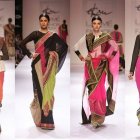 Saree - The Symbol of India's Longstanding Culture: 10 Iconic Sarees for Women, Both Modern and Traditional for Your Pleasure! And 3 Tips to Choose the Right Saree.
Saree - The Symbol of India's Longstanding Culture: 10 Iconic Sarees for Women, Both Modern and Traditional for Your Pleasure! And 3 Tips to Choose the Right Saree.
-
 Bewildered by the Plethora of Options? 10 Trendy Myntra Kurtis that are Sure to Refresh your Wardrobe!
Bewildered by the Plethora of Options? 10 Trendy Myntra Kurtis that are Sure to Refresh your Wardrobe!
The Evergreen Tradition of Sarees in India

Saree is simply the most beloved of garments among most Indian women and girls. It has been in vogue for over 5000 years! No other garment in human history has prevailed for such a long time. Whether it be a shy north Indian girl or a bold south Indian, or anyone from west to east, each and every one of them dream of filing their wardrobes with custom made designer sarees. The age is no issue here, women of every age group crave to get their hands on a gorgeous designer saree. Saree has been a part of our traditions and culture for a long time now, changing its form with a little bit of modification somewhere here and there. From the three-piece saree of ancient India to the modern look of saree we all know, saree has maintained its class and elegance for all these years. Still, it is held as a proud representation of our Indian culture.
The Best Saree Manufacturers AKA 'Saree Centre' of India
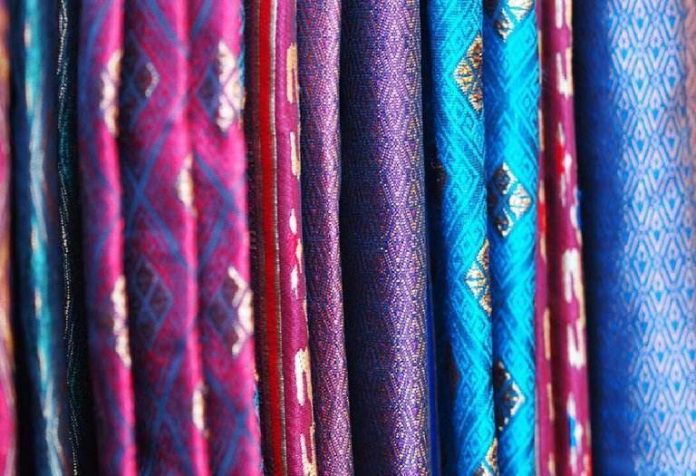
No doubt the sarees are the unimaginably old but so are the methods of saree production, all over India. Different parts of India developed different methods to reach the same basic goal, of making an extremely beautiful saree. Due to these innate differences, these parts of India have their signature top end sarees which allure women all over India in their dreams. These different methods yield different results with particular specialities which are unique to that saree only. These manufacturing hubs of sarees in India, from where the majority of high-quality sarees come from are also known as saree centres of India. These centres are famous for their own signature style and personal touch they add to the product. All these saree centres have different manufacturing and fabricating methods, along with different colouring method which builds the right taste for a variety of people. These centres often have some interesting history behind them. The following are some great and famous saree centres of India.
10 Saree Centres Providing Beautiful Carries with Age Old Trust And Quality
Varanasi, Producer of the Famous Banarasi Sarees
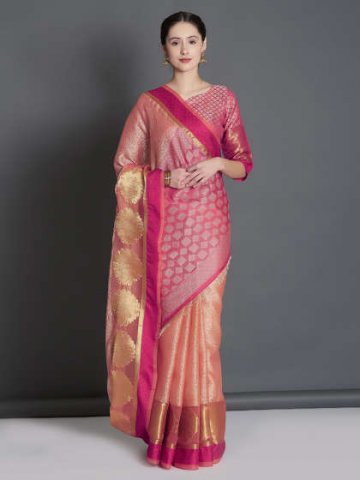
Whenever someone mentions sarees in India, the first name to come up in most people's mind is the "Banarasi saree". For all the good reasons, Varanasi, the city was already an excellent developed hub for academicians, spiritualists, artists’, and artisans, when the rest of the world was just taking it's baby steps towards civilization. That's when the weavers of the area too improved their techniques and manufacturing sarees became second nature to Varanasi. Initially, they used cotton as the raw material but then they included silk into it and found a way to incorporate the newfound spirituality into their works. They represented the hard path that leads to the supreme creator in their designs on sarees. They refuse to incorporate any automatic help in their weaving technique and still weave completely using their hands. These sarees are woven using, pre-dyed in different proportions of colours and pure silk is embellished by designs and motifs using zari. The beautiful zari becomes the main attraction of banarasi sarees and for real, silver and gold zari is done for upper-end costly sarees. A good quality banarasi saree starts at Rs. 2,000 approximately, while for a decent one you will have to spend at least Rs. 6,000, it only goes up from here.
Kolkata, Baluchari Sarees
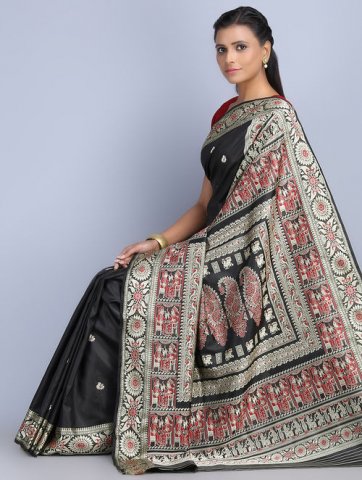
With over 500 years of history, the Baluchari sarees owe their existence and name to West Bengal. The name Baluchari was taken from the small village 'Baluchar', where it all actually started in Murshidabad. They were then centred around Bishnupur, from where they skyrocketed in business after the British rule. Baluchari sarees take their main inspiration from the mythology of India, from the tales of Ramayana and Mahabharata. Sometimes Baluchari sarees show Lord Krishna giving sermons to Arjun during the Mahabharata war, it's a popular scene to be shown. Initially, they were meant to be worn by the upper caste and zamindar families only, that too, during festive and ceremonial occasions. It takes a long time and mastery over skill to create a Baluchari masterpiece. Its take almost a week to complete one, initially they were made by silk yarns but slowly the cotton fabric was also introduced. The weaving is completely natural and uses flower dye, fruits dye, dried twigs, turmeric leaves etc during weaving. A decent Baluchari saree can cost around Rs. 8,000-Rs. 9,000.
Bhubaneswar for the Colourful Sambalpuri
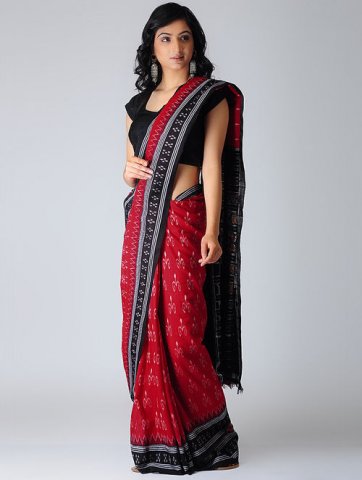
Coming from Bargarh, seven hours from Bhubaneswar, these Sambalpuri sarees take their inspiration from daily life in coastal regions. Incorporating fish or conch motifs in their design along with shankha, chakra and flowers. These sarees are fairly new compared to the other ones, included in our list but still, they manage to make a name for themselves. They first came in everyone's eyes when India prime minister Smt. Indira Gandhi started wearing them, then they gained mainstream popularity in the late '80s and early-mid '90s. This saree is woven on a hand made fabric, some other types of the Sambalpuri sari include Sonepuri, Pasapali, Bomkai, Barpali, and Bapta sarees. These are usually named after their places of origin. Sambalpuri sarees use an original and authentic craft style called 'Baandha'. Initially, geometrical patterns and flora and fauna were inscribed on the sarees, with the passage of time, landscapes and flower patterns were also included. This baandha fabric is made using a technique called ''tye dye". Using this, both sides of the fabric get the same pattern, signature of this technique. You can get a decent Sambalpuri for Rs. 6,000.
Madurai with Its Karaikudi
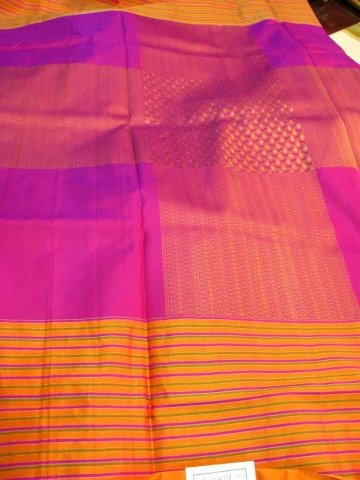
Karaikudi, a village almost 2 hours from Madurai, is home to heavy cotton Chettinad sarees. History tells us that more than 400 years ago, in the 16th century, to be precise, weavers from Saurashtra, Gujarat migrated to Tamilnadu, Andhra Pradesh and coastal Kerala, for economic reasons. The local kings welcomed them into their territory and they settled there. They were called 'patnulkarans'. Their art and techniques flourished in those conditions which led these areas to become big saree manufacturers. The Saurashtrian folks developed their old techniques called 'resist dying and weaving methods'. It actually came from the west and the name changed to Bandhini, which was initially Sungdi. Both silk and cotton are used as fabric for these sarees and compares to other sarees, their borders are broader than usual, little details like stripes, colour contrast and checks are added as embellishments. Their price starts as low as Rs. 700 - Rs. 800 and you can find a good one around Rs. 3,000.
Jaipur Having the Bagru Sarees

On the way from Ajmer to Jaipur, just an hour away from Jaipur, there lives the Chippa community in Bagru village, which uses its 'Dabu' technique to weave 'Bagru' sarees. This saree printing and manufacturing tradition of Bagru village is almost a century old when their ancestors first started it. They still use only natural dyes to colour their beautiful creations. The technique is actually known as 'Block printing'. They use handmade blocks, on which different patterns for each and every season are engraved, and then use a mixture of natural gum, wheat powder, black clay and lime water to dip them in. Afterwards, they stamp it onto the cloth and then leave it for drying. They mostly use cotton as the primary printing fabric. The price ranges from Rs. 600 to Rs.1,000, sometimes even more.
Maheshwari Sarees of Maheshwar
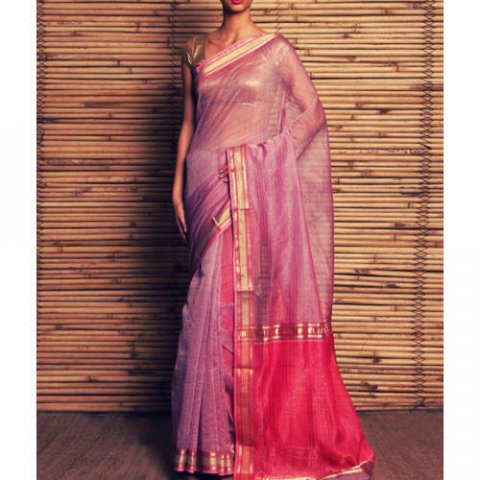
Maheshwari sarees are one of the most beautiful and popular sarees in India, having a loyal customer base not only in India but in international markets too. It is said that more than 200 years ago, in the 18th century, the queen of Maheshwar, Maratha Ahilyabai Holkar sent an invitation to weavers in Surat and Malwa to come and work under her reign to design sarees for royal guests and relatives, which was well received among the weaver community and many of them did move to Maheshwar. That's how Maheshwar is now one of the saree centres of India manufacturing the majestic Maheshwari sarees. The designs of Maheshwari sarees are majorly inspired by the wall designs on the fort of Maheshwar, like chatai, chameli flower, brick patterns etc. Initially, only pure silk was used as the fabric but later cotton, wool and mixed fabric sarees were also introduced. These sarees are available in darker as well as lighter shades. You can find a great quality Maheshwari between the range of Rs. 2,000 to Rs. 5,000.
Patan, Gujarat's Patola
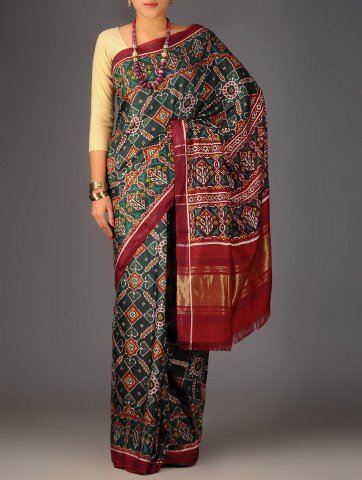
Patola is an extremely celebrated heritage among the three families of Patan, 3 hours away from Gujrat, who are the only ones to know, how to actually weave a Patola. This double ikat woven saree is so delicately made that it takes almost a full year to complete just one saree. This long process includes dying each and every strand separately before finally weaving them together. History tells that King Kumarpal of Solanki destiny took control of almost 700 weavers from Jalna, to weave a special saree containing beautiful geometric patterns inspired by the step wells in Gujarat. Sometimes animals and birds motifs are also used with patterns. The fabric is cotton, and the weaving is a very precise procedure, requiring accuracy up to 1/100th of an inch. The yarn has to pass through multiple cycles of tying and dying to get the desired colours, even a single little displacement can lead to catastrophic results. They were made for the royals so they are inherently expensive. This saree has a vast range of prices, starting at around Rs. 6,000 to go all the way up to lakhs.
Hyderabad, Ikat Sarees
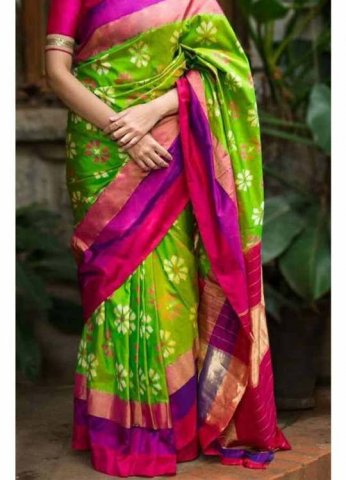
Bhoodan Pochampally, also known as the 'silk city of India' is an hour drive from the metropolitan city of Hyderabad. They use century old weaving technique known as 'Ikat' to make their single and double ikat Pochampally sarees. This sarees are known for their great quality silk fabric and comfort. Bhoodan Pochampally has been a saree centre since the 18th century when the chit-ku weaving art from a small 'Chirala' village was transferred to Pochampally. Starting on a small scale, soon the weavers, the fabric and technique became well known and respected everywhere. Upon reaching the 21st century, the Weaver family had been increased to thousands of people. Their weaving technique produces smooth and clean designs, it takes a normal family about 2 weeks to complete. A unique feature of Pochampally silk saree is the intricate geometric design which spreads over the fabric. These are extremely lightweight and comfortable to wear, only natural colours are used in the dying process and the motifs are generally geometric patterns, sometimes a mix of elephants, parrots, dancing girls etc. You can get a decent Pochampally saree between Rs. 8,000 - Rs. 15,000 while designer ranges from Rs. 30,000 up to Rs. 1,00,000.
Mysore, Karnataka for the Ilkal
The ilkal sarees are well known for the contrast they have between their bright colours. Manufactured in Karnataka, although these sarees are woven in cotton fabric, a separate silk border and pallu is attached to it. Usually, ary silk is used but sometimes pure silk is also used. The embroidery done on these sarees is known as kasturi, that first came into existence in Chalukya dynasty. It was already a weaving centre in ancient India in the 8th century AD. All the raw materials needed for this saree to be made are available in surrounding areas. This easy access helped a lot in the growth of this business. It has a unique feature which joins body wrap with pallu wraps using loops, know as 'Tope teni' technique. These sarees start selling at as low as Rs. 1,000 and you can get a pure silk good quality one around Rs. 8,000.
Guwahati, Assam's Mekhla Sarees
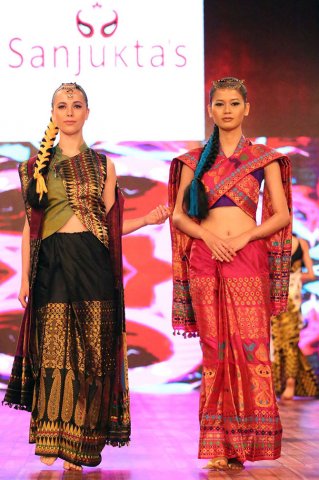
Coming from North east India, Guwahati is famous for its Mekhla sarees. Just 35 km from Guwahati, Saualkuchi is situated; A beautiful village of weavers who create the masterpiece like Mekhla saree. The complete name of the saree is 'Mekhala Chador' and it consists of two main pieces of clothing to wear. The bottom one is Mekhala while the upper body piece is known as Chador. Mekhla was originated in Saualkuchi and the fabric usually used to make it is Muga silk. Sometimes with cotton or Pat silk and eri silk. The special thing is that the designs and patterns on a Meghla are never printed upon; Instead, they are woven into the fabric. It is stitched along the sides of Mekhla and is known as pari. Mekhla sarees are easily available in many stores across Assam and in Guwahati. Some online stores have access to it too. A good quality Meghala will cost you between Rs. 3,000 to Rs. 5,000.
Some of the Best Places to Buy These Sarees in India

- Banaras:
You can find good quality sarees at competitive prices at Chowk, Godoulia Market (Dashswamedh Gali) and Vishwanath Gali in Banaras. - Kota:
To get great sarees in Rajasthan, Kota, you can go to Main Bazaar and the Government Emporia. - Kolkata:
To buy traditional sarees like Baluchari, New Market and the Dakshinapan Shopping Complex are good places in Kolkata. - Mysore:
To buy Pochampally sarees, or even Banarasi ones, places like The State Emporium, Bhojayya Shilpa Silks, Sukri’s Silks and Menaka Silks are good places to go. - Online Stores:
Online stores like Amazon, Flipkart, Myntra, Indiarush, Voonik and Kalki Fashion are some good places to find quality sarees at competitive prices.
-
 The Elegance of Cotton Sarees is Evergreen: 10 Different Types Of Cotton Saree You Must Have in Your Wardrobe (2020)
The Elegance of Cotton Sarees is Evergreen: 10 Different Types Of Cotton Saree You Must Have in Your Wardrobe (2020)
-
 Saree - The Symbol of India's Longstanding Culture: 10 Iconic Sarees for Women, Both Modern and Traditional for Your Pleasure! And 3 Tips to Choose the Right Saree.
Saree - The Symbol of India's Longstanding Culture: 10 Iconic Sarees for Women, Both Modern and Traditional for Your Pleasure! And 3 Tips to Choose the Right Saree.
-
 Bewildered by the Plethora of Options? 10 Trendy Myntra Kurtis that are Sure to Refresh your Wardrobe!
Bewildered by the Plethora of Options? 10 Trendy Myntra Kurtis that are Sure to Refresh your Wardrobe!
-
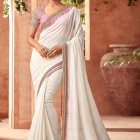 दिव्य सुंदर शिफॉन साड़ी हर मौसम पसंदीदा है: 10 शिफॉन साड़ियों के हमारे अनूठे संग्रह की जांच करें, जिसमें हर वो विशेषता है जिसके लिए आप तरसते हैं (2019)
दिव्य सुंदर शिफॉन साड़ी हर मौसम पसंदीदा है: 10 शिफॉन साड़ियों के हमारे अनूठे संग्रह की जांच करें, जिसमें हर वो विशेषता है जिसके लिए आप तरसते हैं (2019)
-
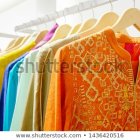 Are You Looking for Affordable as Well as Stylish Kurtis? Update Your Wardrobe with These Stylish And Affordable Online Kurtis (2020)
Are You Looking for Affordable as Well as Stylish Kurtis? Update Your Wardrobe with These Stylish And Affordable Online Kurtis (2020)
Shopping at the Store Is a Unique Experience
Every state in India has a saree that is indigenous to the region and has adopted some characteristics of the place it is from. Earlier it was just restricted to that region alone but now with the arrival of the internet, it has been made famous all over India and the world. Many online stores like Jaypore bringing these traditional wonders to the world. As much as this makes shopping easier for us it also benefits the people who depend on them for their living. Not only online stores you can also visit the region, understand the culture and shop for the products all the while understanding the process.

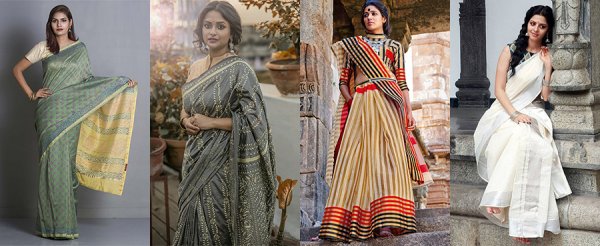
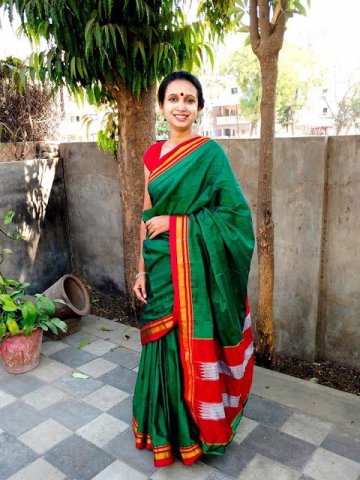
 Highlight the Best Facets of Your Incomparable Beauty: Discover the Best Face Highlighter Currently Available in India and Everything You Need to Know About Using Face Highlighters for Maximum Effect (2023)
Highlight the Best Facets of Your Incomparable Beauty: Discover the Best Face Highlighter Currently Available in India and Everything You Need to Know About Using Face Highlighters for Maximum Effect (2023)
 Forget the Blemishes and Get that Picture Perfect Flawless Radiance on Your Face: Check out the Best Foundations for Oily Skin Currently Available in India and Everything You Need to Know About Makeup Foundations (2023)
Forget the Blemishes and Get that Picture Perfect Flawless Radiance on Your Face: Check out the Best Foundations for Oily Skin Currently Available in India and Everything You Need to Know About Makeup Foundations (2023)
 Make Your Presence Felt Wherever You Go: Discover the Best Perfumes Under 2000 for Both Men and Women to Announce Your Arrival and Make Any Occasion Memorable (2023)
Make Your Presence Felt Wherever You Go: Discover the Best Perfumes Under 2000 for Both Men and Women to Announce Your Arrival and Make Any Occasion Memorable (2023)
 Protect Your Oily Skin from the Harmful Rays of the Sun: Discover the Best Gel Based Sunscreens for Oily Skin and Everything You Need to Know Before Buying One (2023)
Protect Your Oily Skin from the Harmful Rays of the Sun: Discover the Best Gel Based Sunscreens for Oily Skin and Everything You Need to Know Before Buying One (2023)
 Minor Blemishes and Wrinkles Affecting Your Confidence? Check out the Best BB Creams to Conceal Your Worries and Nourish Your Skin to Restore the Healthy, Radiant and Glowing Complexion Back Again (2023)
Minor Blemishes and Wrinkles Affecting Your Confidence? Check out the Best BB Creams to Conceal Your Worries and Nourish Your Skin to Restore the Healthy, Radiant and Glowing Complexion Back Again (2023)
